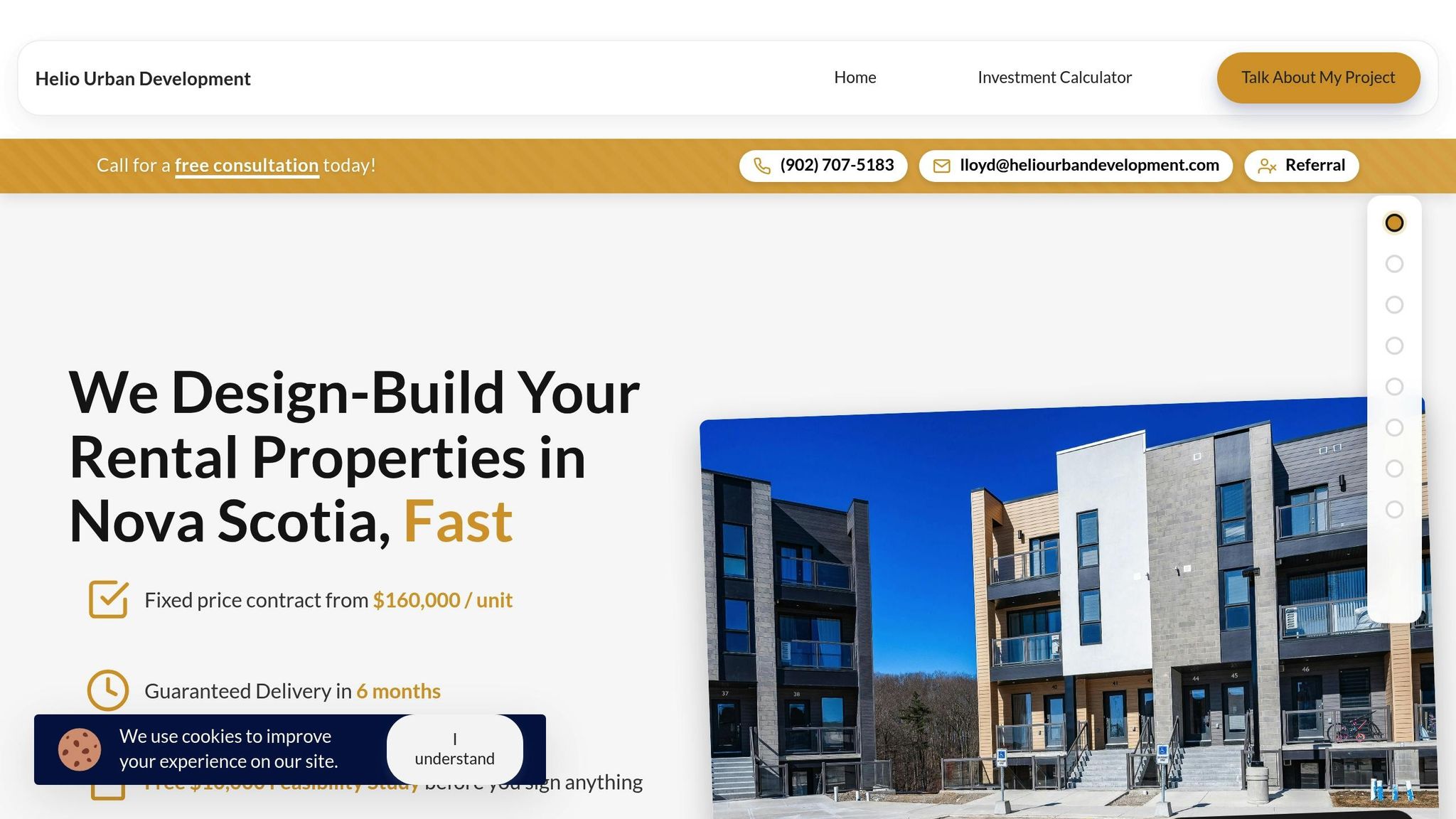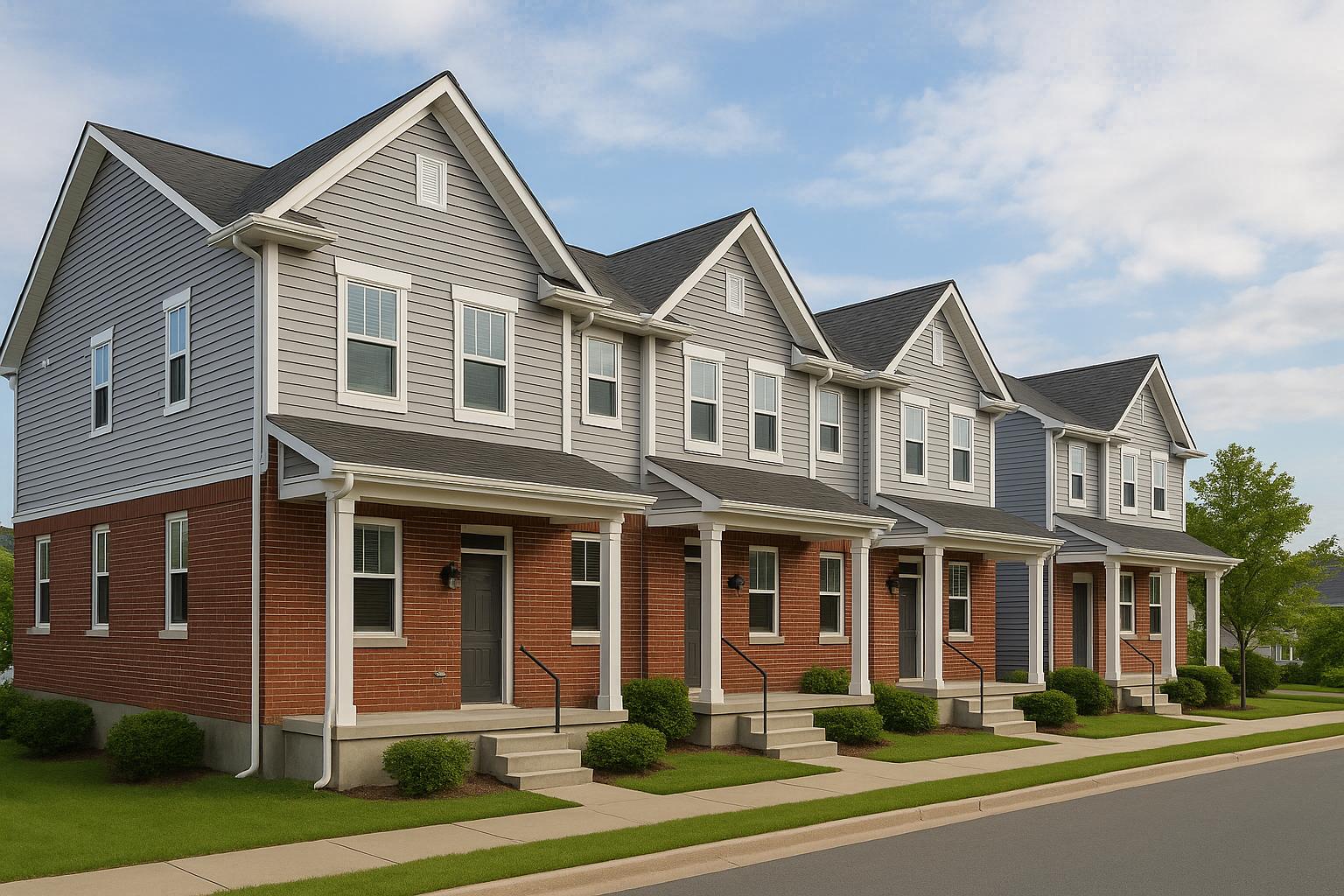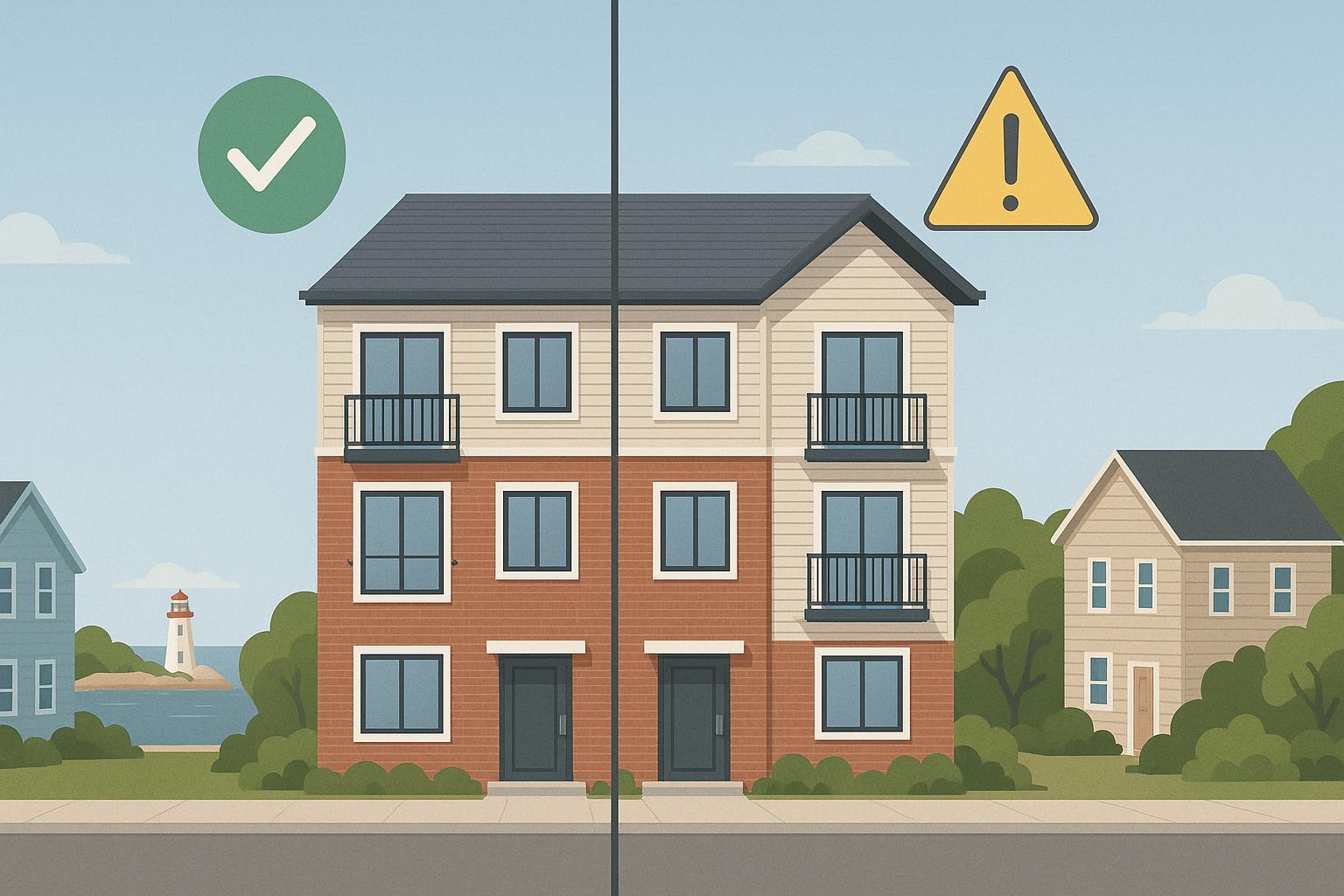Looking to develop in Halifax's ER-3 zones? Here's what you need to know:
- Lot Size & Frontage: Minimum lot size is 325m² (3,500 sq ft) with a 10.7m frontage. These dimensions determine eligibility for 1-4 unit residential developments.
- Zoning Use: ER-3 allows single-family homes, duplexes, triplexes, townhomes, and some mixed-use options like home businesses and daycares.
- Development Potential: Larger lots offer more flexibility, enabling additional units, parking, and outdoor spaces.
- Building Costs: Current construction costs average $160,000–$200,000 per unit, with financing options like CMHC MLI Select providing up to 95% financing and 50-year amortization for energy-efficient builds.
- Rental ROI: 2-bedroom units rent for $1,950–$2,100/month, with a 4-unit property potentially generating $8,000/month in income and an annual ROI of 12–20%.
ER-3 zoning combines housing density with a residential feel, making it ideal for investors and property owners looking to build multi-unit properties in Halifax.
Lot Size Requirements and Development Potential
How Many Units You Can Build Per Lot Size
In ER-3 zones, the size of your lot and its unit density are key factors in determining your development potential. The baseline requirements are a lot size of 325 m² and a frontage of 10.7 m, which establish whether multi-unit development is possible. If your property exceeds these minimums, you gain more room to create thoughtful designs. This extra space can accommodate larger layouts, on-site parking, and outdoor areas that renters value. These features can make your property more attractive in Halifax's competitive rental market. Essentially, the lot size sets the stage for how many units you can build and how functional your property can be.
Building Restrictions and Opportunities
Zoning regulations go beyond lot size to shape what you can build. For example, setback rules require a specific distance between your building and the property lines, which limits the size of your structure. Lot coverage rules dictate how much of the land can be occupied by buildings, while height restrictions define the vertical scale of your project. While these rules may seem limiting, they also encourage creative solutions. Developers often work within these boundaries by using stacked layouts or incorporating shared amenities, such as outdoor spaces or communal areas. These approaches not only meet zoning requirements but can also make the property more functional and appealing to tenants. By understanding these restrictions, you can uncover opportunities to design a property that stands out.
Examples of Lots That Meet ER-3 Requirements
Different types of lots can help illustrate the possibilities under ER-3 zoning. A standard rectangular lot that meets the minimum area and frontage requirements is ideal for a well-planned, multi-storey building. Corner lots, with their dual street frontages, open up more design options. These could include separate entrances for units or layouts that enhance privacy - features that boost tenant satisfaction. Irregularly shaped lots, while more challenging, can be transformed with creative designs like courtyard or terraced layouts. In all cases, frontage plays a critical role. Wider frontages offer more flexibility for parking, driveway placement, and architectural elements, all of which can improve the property's functionality and rental appeal.
How to Maximize Rental Property ROI in ER-3 Zones
Designing Floor Plans That Boost Efficiency and Income
In ER-3 zones, where every square metre matters, well-thought-out floor plans are key to maximizing rental income. For Halifax's current market, designing efficient 2-bedroom units with rents ranging from $1,950 to $2,100 per month is a smart strategy.
To keep construction costs under control while creating appealing layouts, consider open-concept living spaces and centralized plumbing and electrical systems. Aligning bathrooms vertically, for example, reduces the need for extensive plumbing runs, making the design both cost-effective and practical. Additionally, avoid long hallways, prioritize functional kitchen layouts, and position windows strategically to maximize natural light. These thoughtful design choices can help you achieve an annual ROI of 12–20%.
By focusing on efficiency and functionality, you also set the groundwork for smoother code compliance and streamlined project management.
Navigating Halifax Building Codes to Avoid Costly Delays
Meeting Halifax's building codes is critical to keeping ER-3 projects on track and within budget. Multi-unit properties in these zones must adhere to specific regulations, such as fire separation requirements, proper egress window sizes, and stairwell dimensions. Even if your plans align with zoning guidelines, they could still fall short of fire or safety codes, leading to costly redesigns and delays.
One common pitfall is the lack of coordination between design and construction teams. To avoid this, a professional engineer can implement a triple verification process, ensuring all plans meet code requirements before construction begins. This proactive approach can prevent budget overruns, which often range between 30–60% when compliance issues arise mid-project.
Why Design-Build Services Are a Game-Changer
When multiple independent professionals handle different aspects of a project, coordination problems can quickly spiral into costly setbacks. The design-build model simplifies this by integrating design and construction under one roof, ensuring better communication, fixed pricing, and strict timelines.
For ER-3 projects, this approach eliminates inefficiencies that typically cost property owners around $47,000 per project. With fixed construction costs of approximately $160,000 per unit and a guaranteed 6-month completion timeline, you can keep expenses predictable and start generating rental income sooner. For instance, a fourplex built with this model can bring in about $8,000 in monthly rental income.
Additional benefits include financial penalties of up to $1,000 per day for delays, daily progress updates, and a 2-year warranty. These features not only ensure high-quality results but also reduce the stress of managing the project. By aligning perfectly with ER-3 development needs, the design-build approach helps you maximize returns while keeping your project on track.
Construction Costs and Financing for ER-3 Developments
Construction Costs and Budget Planning
Developing ER-3 multi-unit projects requires careful financial planning, especially as construction costs continue to rise. According to the Building Construction Price Index, residential building costs jumped by 5.5% between 2023 and 2024[1]. This makes precise budgeting more important than ever.
Having a clear understanding of costs can prevent budget overruns, which can sometimes inflate expenses by 30–60% due to coordination issues. For instance, if you know your fourplex will cost $640,000 to build, you can secure the right financing and calculate your expected returns with confidence. This aligns well with earlier discussions on the efficiencies of integrated design-build models. In 2024, townhouse-style developments saw the steepest cost increases at 6.4%, while apartment-style buildings experienced a more moderate rise of 4.8%[1]. These figures underline the importance of tailoring financing strategies to meet specific project needs.
Financing Options for Property Owners
To tackle rising costs, property owners often turn to flexible financing options. ER-3 projects benefit from tools like CMHC MLI Select financing, which offers up to 95% financing with just a 5% down payment for energy-efficient buildings. This high loan-to-value ratio provides significant leverage, enabling property owners to build more units with the same capital. For example, instead of the usual 5:1 leverage seen with conventional financing, CMHC MLI Select allows for up to 20:1 leverage.
Another key advantage of this program is its 50-year amortization period, which reduces monthly payments and improves cash flow from the outset. To qualify, buildings must exceed standard energy efficiency codes by 40%. While this raises construction costs to around $200,000 per unit, the financing benefits - reduced down payments and better cash flow - often outweigh the added expense. Additionally, a guaranteed 6-month construction timeline helps keep carrying costs lower compared to the industry average of 12–18 months.
Expected Rental Income and ROI
ER-3 developments in Halifax offer strong rental income potential. Current market rates for 2-bedroom units range between $1,950 and $2,100 per month. This means a typical fourplex can generate around $8,000 in monthly rental income, or approximately $96,000 annually. With a total construction cost of $640,000, this translates to an annual ROI of 12–20%, depending on land costs and financing terms.
CMHC MLI Select financing further boosts cash flow by offering high loan-to-value ratios. While unit costs may increase to $200,000, the 95% financing and 50-year amortization often result in immediate positive cash flow. For example, a property owner could build an $800,000 fourplex with just a $40,000 down payment and still achieve the same $8,000 in monthly rental income.
Timely construction is critical for maintaining profitability. Each month of delay can result in approximately $8,000 in lost rental income. To mitigate this, some projects include financial penalties of up to $1,000 per day for delays, ensuring construction stays on schedule and rental income begins as planned.
sbb-itb-16b8a48
Building Multi-Unit Properties in ER-3 Zones
Key Points to Remember
Understanding ER-3 zoning is essential for tapping into Halifax's multi-unit development opportunities. ER-3 zoning lays out clear guidelines that allow for controlled density and creative design within its set parameters. To make the most of this zoning, it's crucial to follow its specific requirements for lot size and frontage, which support projects like fourplexes and larger buildings.
Fixed-price construction is a game-changer, helping developers avoid common cost overruns that can range between 30% and 60%. Meeting energy efficiency standards also opens doors to better financing options, such as CMHC MLI Select. By building to energy standards that are about 40% more efficient than the standard code, unit costs rise to around $200,000. However, this approach allows developers to access financing for up to 95% of the project cost with a 50-year amortisation, often leading to immediate positive cash flow. In short, this strategy enables property owners to stretch their capital further and build more units.
Timelines are just as critical. While the industry norm for project completion is 12 to 18 months, a guaranteed 6-month construction timeline can drastically cut carrying costs and bring in rental income faster. For context, every month of delay costs about $8,800 in lost rental revenue. That's why financial penalties - up to $1,000 per day for delays - are pivotal for holding teams accountable. These strategies align perfectly with the integrated solutions provided by Helio Urban Development.
How Helio Urban Development Can Help

Helio Urban Development simplifies the entire process of ER-3 development, ensuring a smooth path from planning to completion. By aligning with ER-3's predictable framework and cost structure, Helio delivers integrated solutions that eliminate common challenges like coordination issues, cost overruns, and delays. As Nova Scotia’s only integrated design-build company focused on 4+ unit rental properties, Helio unites planners, architects, engineers, and builders under one roof.
Helio’s fixed-price model - set at $160,000 per unit - includes premium features such as triple-pane windows, quartz countertops, engineered hardwood floors, and ductless heat pumps. For property owners aiming to maximise financing, these energy-efficient builds qualify for 95% financing with a 50-year amortisation.
Co-founder Lloyd Liu guarantees on-time delivery, with financial penalties in place for any delays. Currently, Helio has 31 units under construction and 131 more in the planning stages across Nova Scotia, serving areas within a 90-minute radius of Halifax.
Transparency is another cornerstone of Helio’s approach. The company provides daily photo updates through its scheduling system, ensuring property owners are informed every step of the way. Combined with triple quality checks, this process helps clients achieve an annual ROI of 12–20%, making ER-3 development not just feasible but highly profitable.
3306 Windsor St, Halifax, NS Presented by Assist 2 Sell, HomeWorks Realty Ltd..

FAQs
What are the advantages of using a design-build service for ER-3 zone projects in Halifax?
Using a design-build service for ER-3 zone projects in Halifax comes with several clear benefits. By bringing together the design and construction teams from the beginning, this method helps to streamline the workflow, cut down on delays, and speed up project completion. The use of fixed-price contracts and value engineering further supports cost control, making it easier for property owners to stay within budget and achieve better returns on their investment.
Another advantage is the simplicity it brings to project management. With single accountability, there’s less room for uncertainty, and the quality remains consistent throughout. Thanks to predictable timelines and an organized approach, design-build services are a smart choice for property owners aiming to develop successful multi-unit rental properties within ER-3 zoning guidelines in Halifax.
What strategies can property owners use to maximize returns when building multi-unit properties in Halifax's ER-3 zones?
To get the most out of properties in ER-3 zones, it’s all about making smart use of the land and adopting efficient construction methods. Since ER-3 zoning allows up to eight units per lot, options like row housing or compact multi-unit buildings are great for spreading out fixed costs while maximising rental income.
Using a fixed-price construction model can help keep costs predictable and simplify the overall process. With a lot size of 325 m² (3,500 sq ft) and a 10.7 m frontage to work with, careful planning is key to staying compliant while packing in as much density as possible. Sticking to single-accountability construction methods can also help avoid delays and unexpected expenses, making the project more profitable and hassle-free.
What financing options are available for energy-efficient builds in Halifax's ER-3 zones, and how can they help reduce costs and improve cash flow?
Property owners developing energy-efficient rental properties in Halifax's ER-3 zones have access to several financing options designed to ease the financial burden. One standout program is the CMHC MLI Select, which offers up to 95% loan-to-value financing for multi-unit projects that prioritize energy efficiency. This can significantly reduce the upfront costs of construction. Another great option is the Canada Greener Homes Loan, which provides interest-free financing specifically for energy upgrades, making sustainable construction more achievable.
These financing programs do more than just lower initial expenses - they also enhance long-term profitability. By cutting energy costs and tapping into government-backed incentives, property owners can create rental properties that are not only better for the environment but also more financially rewarding, all while adhering to ER-3 zoning regulations.



